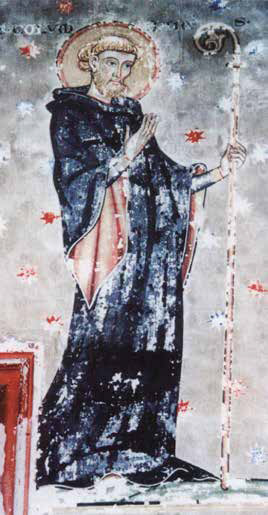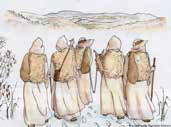St. Columbanus, Myshall
Myshall has a strong connection to 11 St. Columbanus who, according to his biographer, was born in Leinster and spent his early years there. The border area between Counties Wexford and Carlow and the village of Myshall in particular, have long been believed to have nurtured the saint.
Tradition also holds that Columbanus was advised by St. Croine Bheag, a recluse of Carlow (see St. Patrick’s Trail) to leave home to follow his monastic education. His journey took him from the south to the north of Ireland and eventually to Bangor in Co. Down whose monastery had a close association with Carlow town. From Bangor, Columbanus set off on his great missionary journey to the continent where he founded many monasteries including Luxeuil in France and Bobbio in Italy.
Columbanus was described by Cardinal Tomás Ó Fiaich as ‘Ireland’s first European, a poet, scholar, abbot, preacher and teacher’. He founded monasteries, associated with kings and corresponded with popes. Many of Columbanus’ writings survive and they consistently inspire and encourage.
Plans for a Columban Way (Turas Columbanus) are at an advanced stage. This will link the places visited by the saint on the continent with the sites associated with his early life and education in Ireland. Following in the footsteps of the saint, it will traverse beautiful, peaceful landscapes, stopping at shrines and sacred places and afford opportunities for contemplation and reconnection with social and spiritual values.
A tapestry to honour St. Columbanus was made by local ladies in 2015 to commemorate the 1400th anniversary of the saint’s death and can be viewed in the Church of Exaltation in the village centre.
DID YOU KNOW…
Columbanus was an early exponent of European harmony and unity. He wrote ‘We are all members of one body, whether Franks or Britons or Irish or whatever our race’. As an immigrant in the heart of Europe, he pleaded for toleration and accommodation. His example influenced Robert Schuman, the postwar French foreign minister and architect of the modern European Union.



Leave a Comment